Forecasting of Power Output of a PVPS Based on Meteorological Data Using RNN Approaches
Abstract
:1. Introduction
2. Methodology
2.1. Modeling Approach
2.2. Design and Implementation of ANN
2.2.1. Inputs and Output
2.2.2. Model Implementation
2.3. Importance of the Dataset
2.4. Evaluation of the Model Performance
3. Results and Discussion
3.1. Power Output of the System
3.2. Optimal Design of the Network
3.3. RNN Capability in Predicting Output Power of PVPS
4. Conclusions
Author Contributions
Funding
Institutional Review Board Statement
Informed Consent Statement
Data Availability Statement
Conflicts of Interest
References
- Kalogirou, S.A.; Neocleous, C.; Paschiardis, S.; Schizas, C. Wind speed prediction using artificial neural networks. In Proceedings of the European Symp. on Intelligent Techniques ESIT′99, Crete, Greece, 3–4 June 1999. [Google Scholar]
- Huang, R.; Huang, T.; Gadh, R. Solar generation prediction using the ARMA model in a laboratory-level micro-grid. In Proceedings of the IEEE SmartGridComm 2012 Symposium—Support for Storage, Renewable Sources, and MicroGrid, Tainan, Taiwan, 5–8 November 2012. [Google Scholar]
- Torki-Harchegani, M.; Ebrahimi, R.; Mahmoodi-Eshkaftaki, M. Almond production in Iran: An analysis of energy use efficiency (2008–2011). Renew. Sustain. Energy Rev. 2015, 41, 217–224. [Google Scholar] [CrossRef]
- Cortés, B.; Sánchez, R.T.; Flores, J.J. Characterization of a polycrystalline photovoltaic cell using artificial neural networks. Sol. Energy 2019, 196, 157–167. [Google Scholar] [CrossRef]
- Mason, K.; Reno, M.J.; Blakley, L.; Vejdan, S.; Grijalva, S. A deep neural network approach for behind-the-meter residential PV size, tilt and azimuth estimation. Sol. Energy 2020, 196, 260–269. [Google Scholar] [CrossRef]
- Mohamed, A.A.; Metwally, H.; El-Sayed, A.; Selem, S. Predictive neural network based adaptive controller for grid-connected PV systems supplying pulse-load. Sol. Energy 2019, 193, 139–147. [Google Scholar] [CrossRef]
- Mittal, M.; Bora, B.; Saxena, S.; Gaur, A.M. Performance prediction of PV module using electrical equivalent model and artificial neural network. Sol. Energy 2018, 176, 104–117. [Google Scholar] [CrossRef]
- Elsheikh, A.H.; Sharshir, S.W.; Elaziz, M.A.; Kabeel, A.; Guilan, W.; Haiou, Z. Modeling of solar energy systems using artificial neural network: A comprehensive review. Sol. Energy 2019, 180, 622–639. [Google Scholar] [CrossRef]
- Rodríguez, F.; Fleetwood, A.; Galarza, A.; Fontán, L. Predicting solar energy generation through artificial neural networks using weather forecasts for microgrid control. Renew. Energy 2018, 126, 855–864. [Google Scholar] [CrossRef]
- Larson, D.; Nonnenmacher, L.; Coimbra, C.F. Day-ahead forecasting of solar power output from photovoltaic plants in the American Southwest. Renew. Energy 2016, 91, 11–20. [Google Scholar] [CrossRef]
- Saberian, A.; Hizam, H.; Radzi, M.A.M.; Ab Kadir, M.Z.A.; Mirzaei, M. Modelling and Prediction of Photovoltaic Power Output Using Artificial Neural Networks. Int. J. Photoenergy 2014, 2014, 469701. [Google Scholar] [CrossRef] [Green Version]
- Ibnelouad, A.; El Kari, A.; Ayad, H.; Mjahed, M. Improved cooperative artificial neural network—Particle swarm optimization approach for solar photovoltaic systems using maximum power point tracking. Int. Trans. Electr. Energy Syst. 2020, 30, e12439. [Google Scholar] [CrossRef]
- Zhao, P.; Wang, J.; Xia, J.; Dai, Y.; Sheng, Y.; Yue, J. Performance evaluation and accuracy enhancement of a day-ahead wind power forecasting system in China. Renew. Energy 2012, 43, 234–241. [Google Scholar] [CrossRef]
- Haykin, S. Neural Networks and Learning Machines, 3rd ed.; Pearson Education, Inc.: Upper Saddle River, NJ, USA, 2009. [Google Scholar]
- Vidyanandan, K.V. An overview of factors affecting the performance of solar PV systems. Energy Scan 2017, 27, 2–8. [Google Scholar]
- Zakzouk, A.K.M.; Alamoud, A.R.M.; Khoshaim, B.H. Factors Affecting the Performance of a Photovoltaic Power System (PVPS). Int. J. Sol. Energy 1987, 5, 67–81. [Google Scholar] [CrossRef]
- Park, N.C.; Oh, W.W.; Kim, D.H. Effect of Temperature and Humidity on the Degradation Rate of Multicrystalline Silicon Photovoltaic Module. Int. J. Photoenergy 2013, 2013, 925280. [Google Scholar] [CrossRef] [Green Version]
- Chaichaan, M.; Kazem, H. Experimental analysis of solar intensity on photovoltaic in hot and humid weather conditions. Int. J. Sci. Eng. Res. 2016, 7, 91–96. [Google Scholar]
- Hamdi, R.T.A.; Hafad, S.A.; Kazem, H.A.; Chaichan, M.T. Humidity impact on photovoltaic cells performance: A review. Int. J. Recent Eng. Res. Develop. 2018, 3, 27–37. [Google Scholar]
- Amajama, J. Effect of air pressure on the output of photovoltaic panel and solar illuminance (or Intensity). Int. J. Sci. Eng. Appl. Sci. 2016, 2, 139–144. [Google Scholar]
- Mellit, A.; Pavan, A.M. A 24-h forecast of solar irradiance using artificial neural network: Application for performance prediction of a grid-connected PV plant at Trieste, Italy. Sol. Energy 2010, 84, 807–821. [Google Scholar] [CrossRef]
- Šestanović, T.; Arnerić, J. Can Recurrent Neural Networks Predict Inflation in Euro Zone as Good as Professional Forecasters? Mathematics 2021, 9, 2486. [Google Scholar] [CrossRef]
- Beigi, M.; Torki-Harchegani, M.; Tohidi, M. Experimental and ANN modeling investigations of energy traits for rough rice drying. Energy 2017, 141, 2196–2205. [Google Scholar] [CrossRef]
- Mohammed, L.B.; Hamdan, M.A.; Abdelhafez, E.A.; Shaheen, W. Hourly solar radiation prediction based on nonlinear autoregressive exogenous (Narx) neural network. Jordan J. Mech. Ind. Eng. 2013, 7, 11–18. [Google Scholar]
- Husein, M.; Chung, I.-Y. Day-Ahead Solar Irradiance Forecasting for Microgrids Using a Long Short-Term Memory Recurrent Neural Network: A Deep Learning Approach. Energies 2019, 12, 1856. [Google Scholar] [CrossRef] [Green Version]
- Taghadomi-Saberi, S.; Razavi, S.J. Evaluating potential of artificial neural network and neuro-fuzzy techniques for global solar radiation prediction in Isfahan, Iran. J. Agric. Sci. Tech. 2019, 21, 295–307. [Google Scholar]
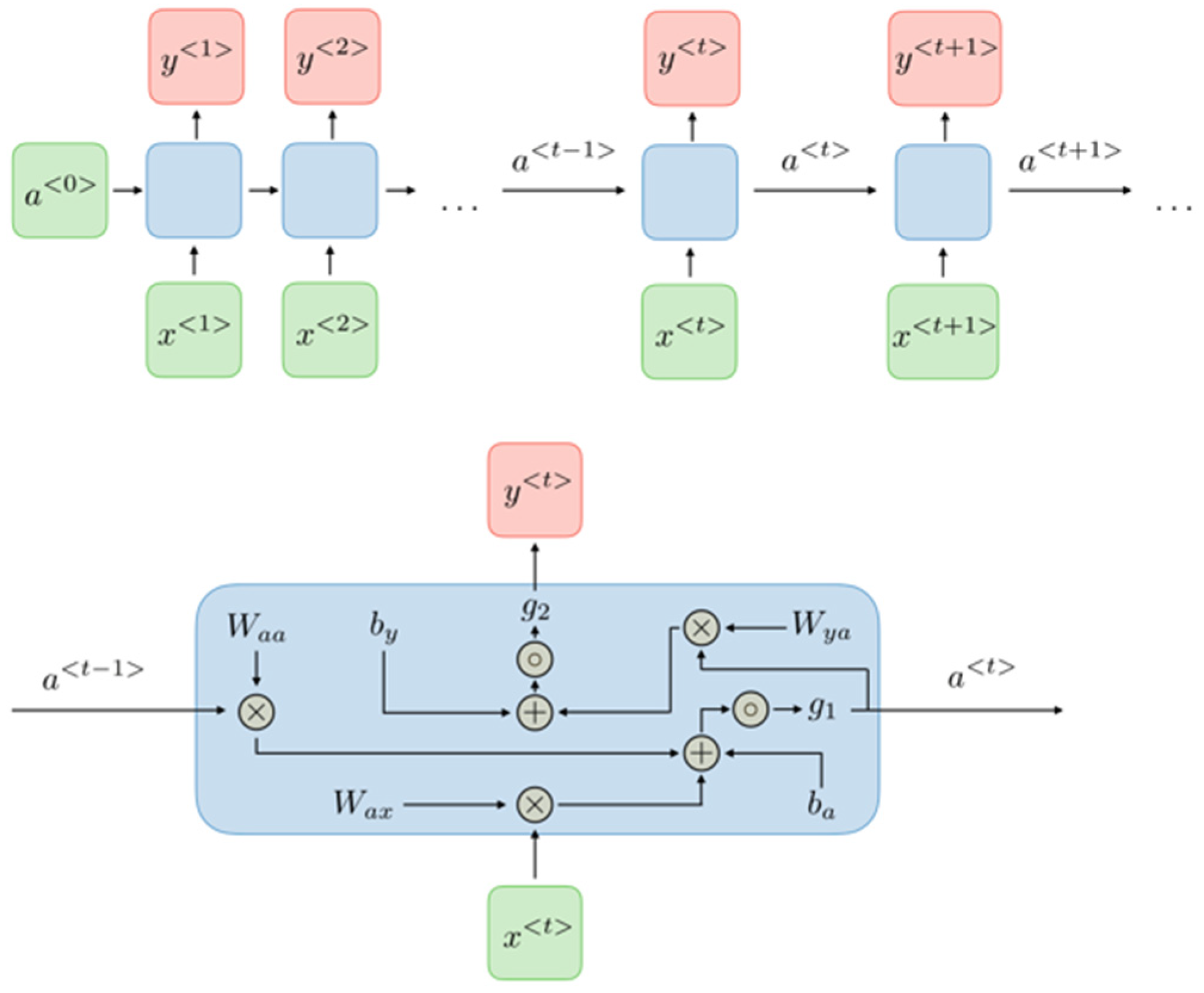



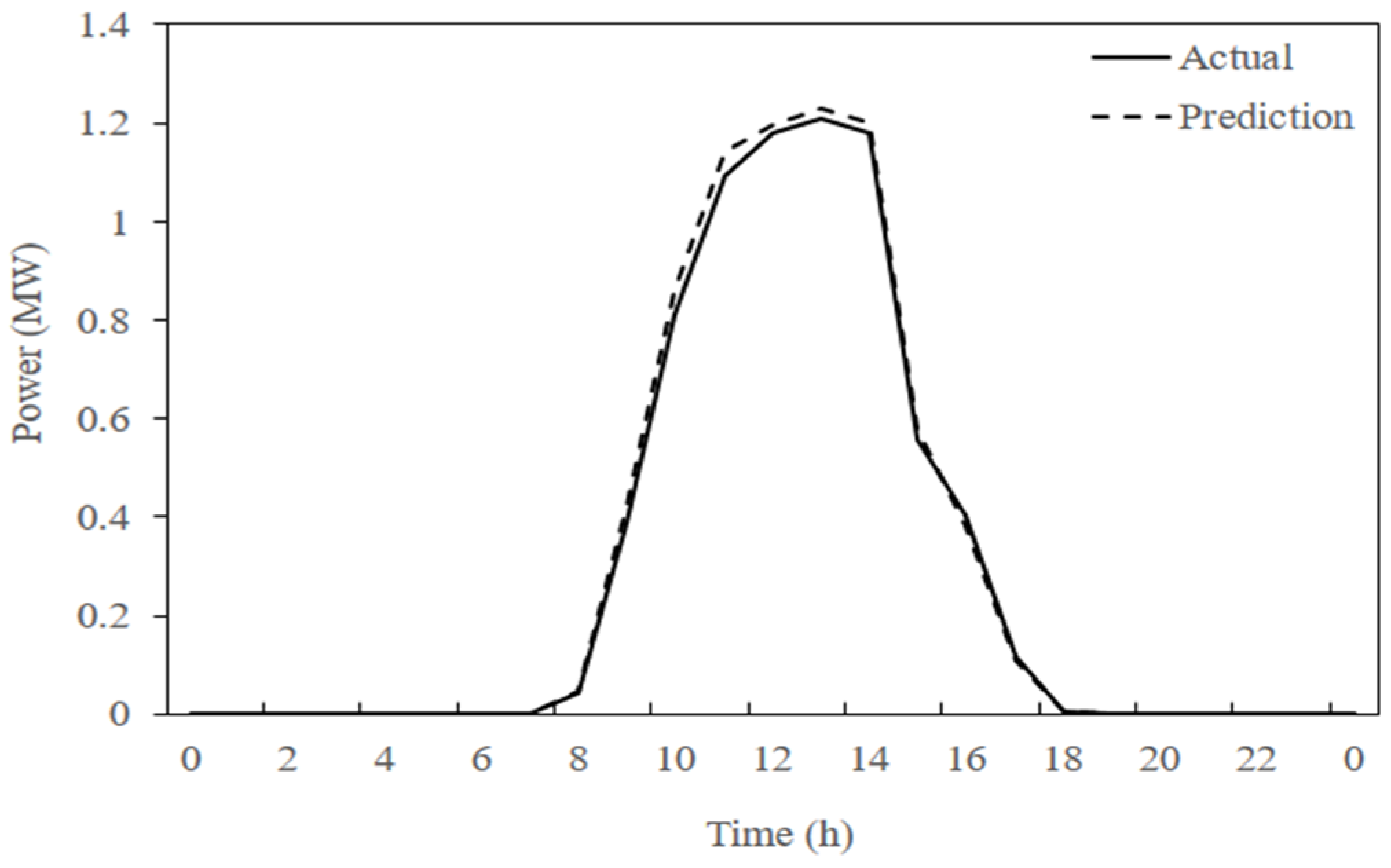

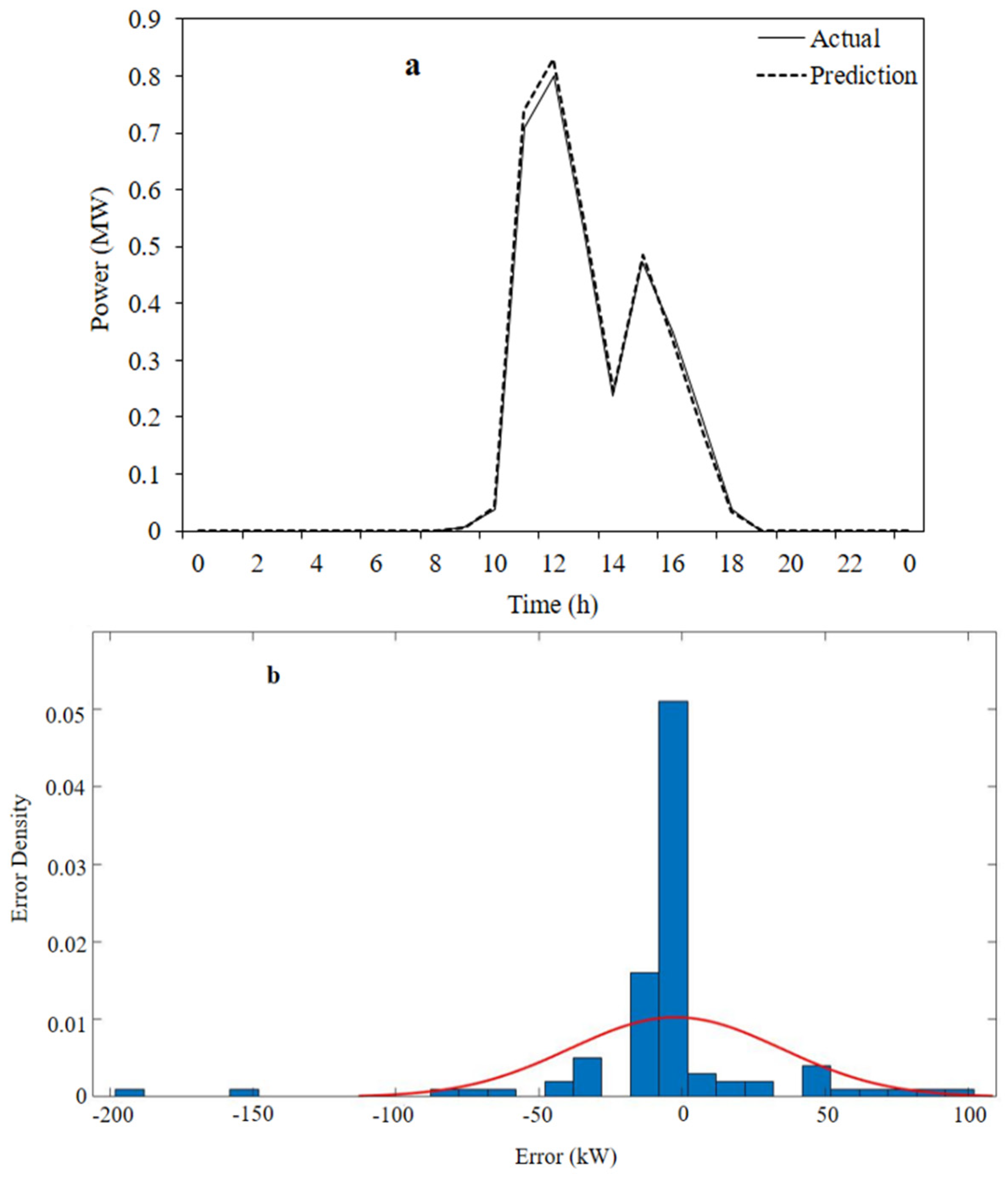
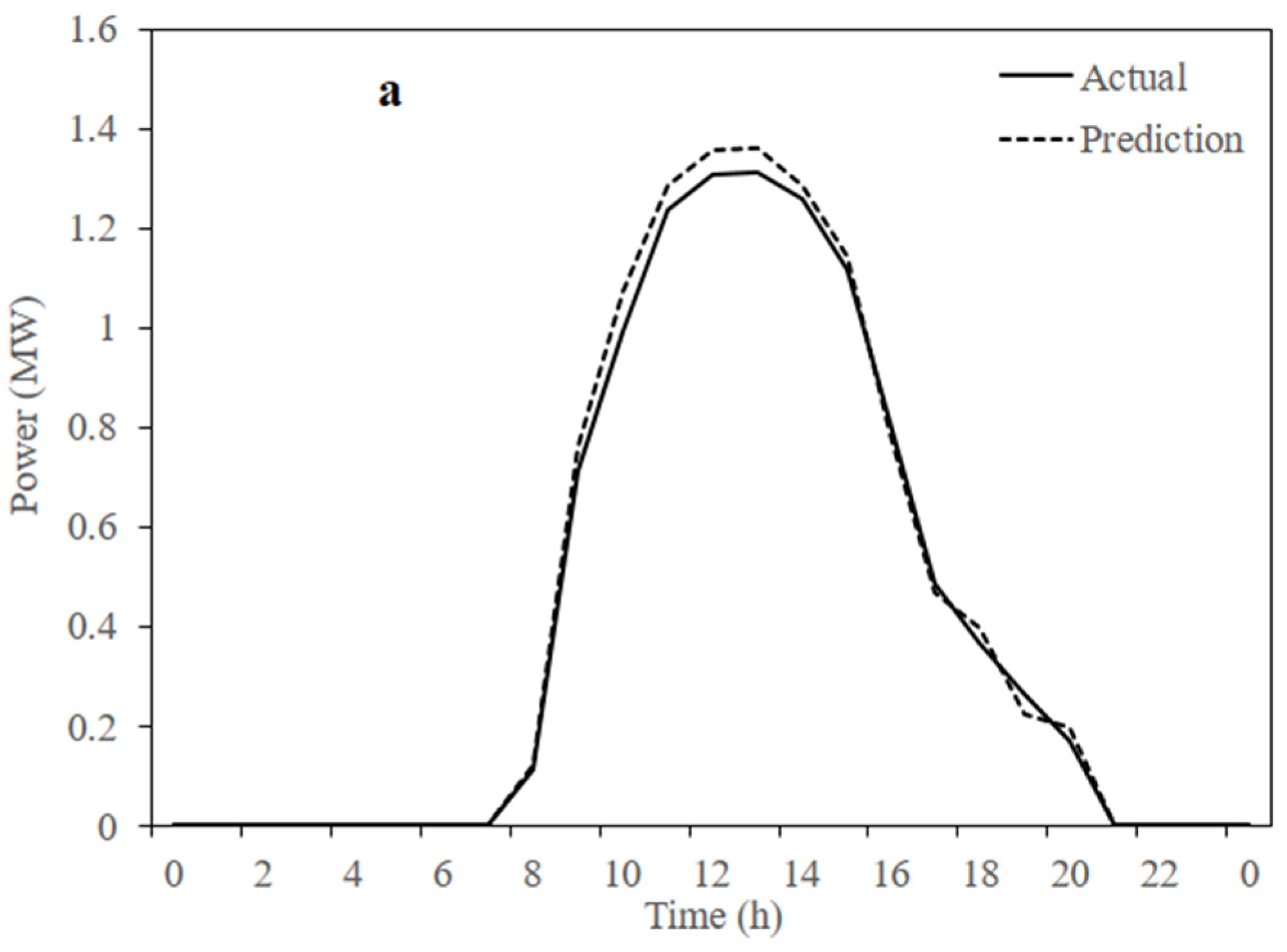
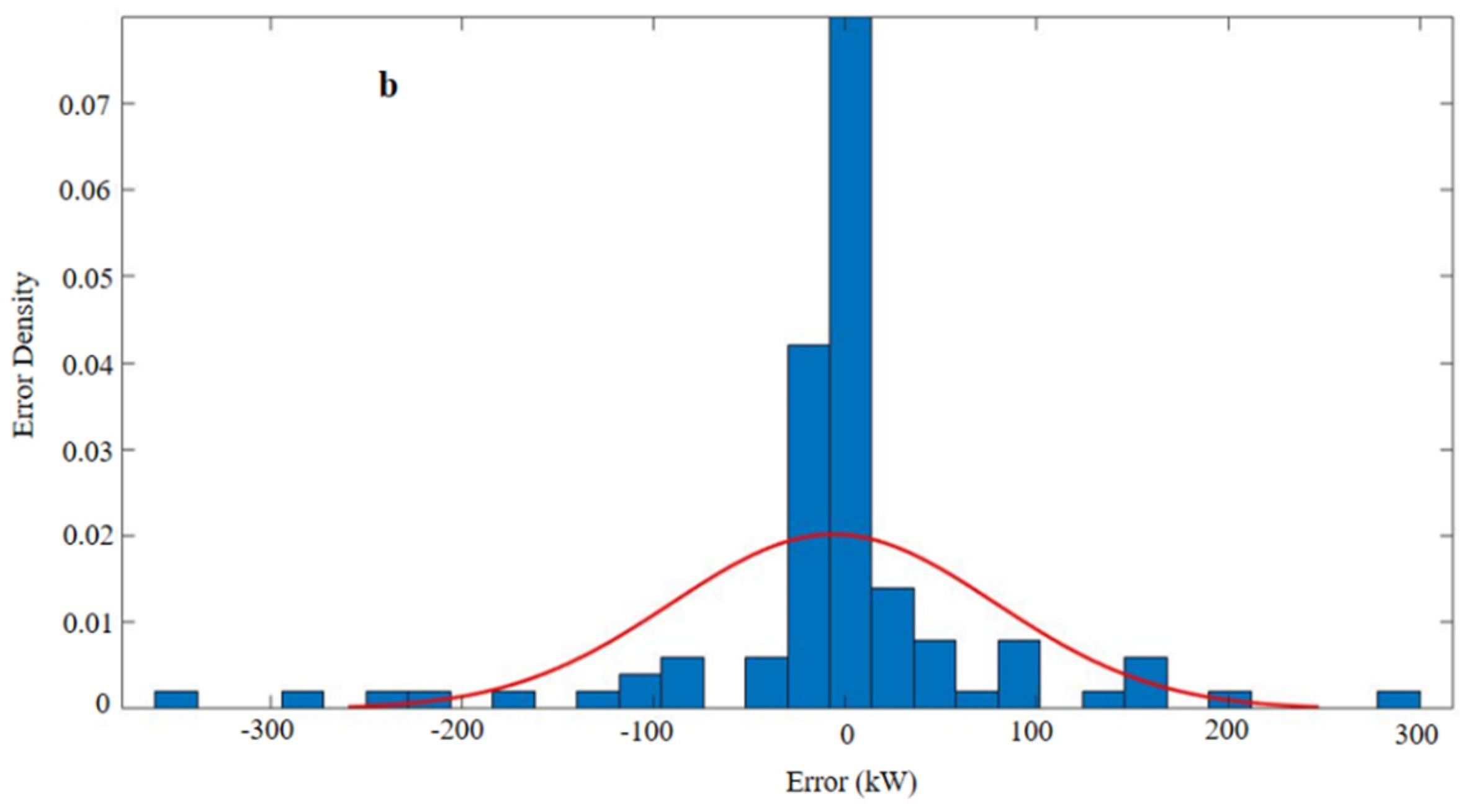
| Date | Sunrise | Sunset | Maximum Irradiation (W/m2) | Maximum Power Output (MW) | Average Power Output (MW) |
|---|---|---|---|---|---|
| 21 March 2018 | 6:10 | 18:20 | 1118 | 1.377 | 0.425 |
| 4 August 2019 | 6:20 | 20:00 | 1294 | 1.207 | 0.381 |
| 1 October 2018 | 6:00 | 17:50 | 1077 | 1.112 | 0.301 |
| 10 February 2019 | 6:50 | 17:50 | 776 | 1.272 | 0.349 |
| Test No | Neurons | Delays | Iterations | RMSEtrain | RMSEtest |
|---|---|---|---|---|---|
| 1 | 5 | 1:2 | 20 | 0.0314 | 0.0318 |
| 2 | 12 | 1:2 | 20 | 0.0288 | 0.0296 |
| 3 | 12 | 1:3 | 20 | 0.0354 | 0.0362 |
| 4 | 12 | 1:4 | 20 | 0.0355 | 0.0363 |
| 5 | 12 | 1:5 | 20 | 0.0408 | 0.0418 |
| 6 | 12 | 1:6 | 20 | 0.0411 | 0.0416 |
| 7 | 15 | 1:2 | 20 | 0.0425 | 0.0436 |
| 8 | 20 | 1:2 | 20 | 0.0433 | 0.0442 |
| Network Type | Recurrent Neural Network |
|---|---|
| Inputs | Season, time, irradiation, temperature, relative humidity, air pressure, and wind speed |
| Output | Power |
| Number of layers | 3 layers (input, hidden, output) |
| Number of hidden neurons | 12 |
| Number of delay | 1:2 |
| Activation functions | Log-sigmoid and linear |
| Learning algorithm | Levenberg–Marquardt |
Publisher’s Note: MDPI stays neutral with regard to jurisdictional claims in published maps and institutional affiliations. |
© 2022 by the authors. Licensee MDPI, Basel, Switzerland. This article is an open access article distributed under the terms and conditions of the Creative Commons Attribution (CC BY) license (https://creativecommons.org/licenses/by/4.0/).
Share and Cite
Beigi, M.; Beigi Harchegani, H.; Torki, M.; Kaveh, M.; Szymanek, M.; Khalife, E.; Dziwulski, J. Forecasting of Power Output of a PVPS Based on Meteorological Data Using RNN Approaches. Sustainability 2022, 14, 3104. https://doi.org/10.3390/su14053104
Beigi M, Beigi Harchegani H, Torki M, Kaveh M, Szymanek M, Khalife E, Dziwulski J. Forecasting of Power Output of a PVPS Based on Meteorological Data Using RNN Approaches. Sustainability. 2022; 14(5):3104. https://doi.org/10.3390/su14053104
Chicago/Turabian StyleBeigi, Mohsen, Hossein Beigi Harchegani, Mehdi Torki, Mohammad Kaveh, Mariusz Szymanek, Esmail Khalife, and Jacek Dziwulski. 2022. "Forecasting of Power Output of a PVPS Based on Meteorological Data Using RNN Approaches" Sustainability 14, no. 5: 3104. https://doi.org/10.3390/su14053104
APA StyleBeigi, M., Beigi Harchegani, H., Torki, M., Kaveh, M., Szymanek, M., Khalife, E., & Dziwulski, J. (2022). Forecasting of Power Output of a PVPS Based on Meteorological Data Using RNN Approaches. Sustainability, 14(5), 3104. https://doi.org/10.3390/su14053104







